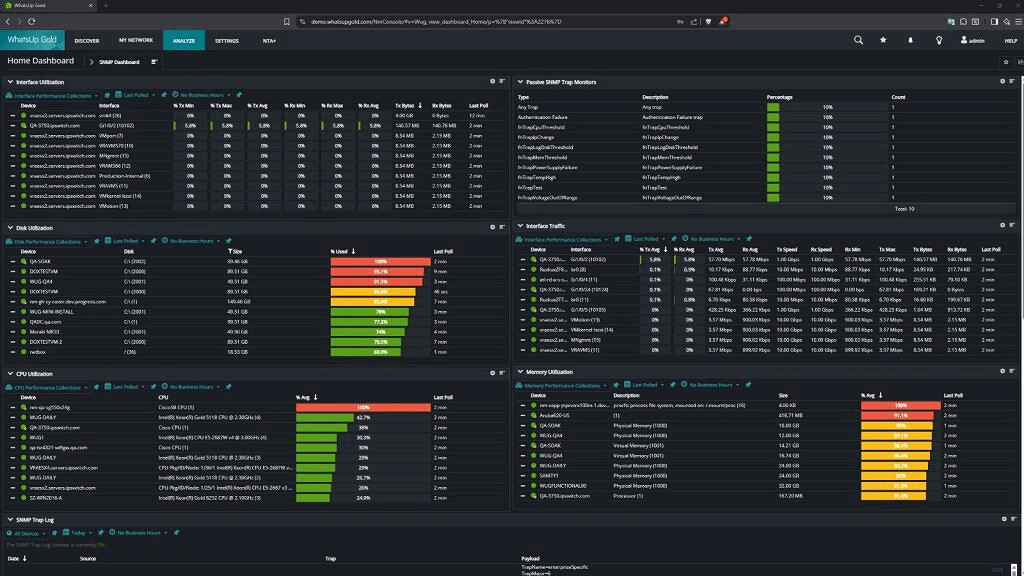SNMP Monitoring Tools & Software
Effortless SNMP monitoring with WhatsUp Gold.
Gain real-time insights and total control over your infrastructure.
How WhatsUp Gold Transforms
SNMP Monitoring
Take the complexity out of network management. WhatsUp Gold delivers powerful SNMP monitoring capabilities through an intuitive,
real-time platform.

Real-time alerts and network health monitoring in action
Proactive Monitoring
Detect and resolve network issues before they impact business operations. WhatsUp Gold continuously scans your environment, identifying potential problems early so you can act fast.
Real-Time Alerts & Notifications
Stay informed with customizable alerts delivered via email, SMS, or push notifications. Whether you're in the office or on the go, you'll never miss a critical event.
User-Friendly Dashboard
No steep learning curve. The intuitive interface makes it easy to visualize network performance, drill into device details, and manage alerts with just a few clicks.
Scalable & Flexible
From small businesses to large enterprises, WhatsUp Gold adapts to your needs. Monitor thousands of devices across cloud, hybrid, or on-prem environments with ease.
What Sets WhatsUp Gold’s SNMP Monitoring Tools Apart
Intelligent SNMP Device Discovery
Saves IT teams time and ensures no device is overlooked.
Advanced Performance Metrics
Provides deep visibility into network performance and bandwidth usage.
Customizable Alerts & Automation
Prevent downtime and boost efficiency with smart alerting and workflows.
Historical Data & Reporting
Improve decision-making and plan network upgrades with confidence.
Secure & Scalable for Any Environment
Built-in encryption and role-based access control ensure your data stays protected.
WhatsUp Gold is Easily Integrated & Deployed
Get up and running in minutes, not days.
- Quick & Easy Setup: Install in minutes with minimal configuration.
- Integrates with Existing IT Systems: Compatible with AWS, Azure, VMware, Microsoft, and more.
- Works Across Any Infrastructure: Cloud, hybrid, and on-premises environments supported.
What IT Professionals Think About WhatsUp Gold






WhatsUp Gold Earns High Marks in Latest G2 Report
WhatsUp Gold has been recognized as an industry leading network monitoring tool in the recent G2 Grid Report for network monitoring solutions winning 17 total awards overall.
Read ReportFrequently Asked Questions
What is SNMP Monitoring?
SNMP monitoring is the process of using the Simple Network Management Protocol to track the performance, availability, and health of network devices. It enables IT teams to collect real-time data, receive alerts, and manage configurations across routers, switches, servers, and more.
What is the Purpose of SNMP?
SNMP is designed to simplify network management. It allows administrators to monitor device status, detect issues, and automate responses, all from a centralized platform.
Is WhatsUp Gold compatible with Windows SNMP servers?
Yes. WhatsUp Gold is fully compatible with Windows SNMP servers and offers seamless integration. Learn more about SNMP monitoring software
Does WhatsUp Gold support cloud-based SNMP monitoring?
Absolutely. WhatsUp Gold supports SNMP monitoring across cloud, hybrid, and on-premises environments.
How does WhatsUp Gold compare to SolarWinds?
WhatsUp Gold offers a powerful, cost-effective alternative to SolarWinds with a more intuitive interface and faster time to value. See the full comparison
Get Started
Complete the form to download your free trial of WhatsUp Gold.